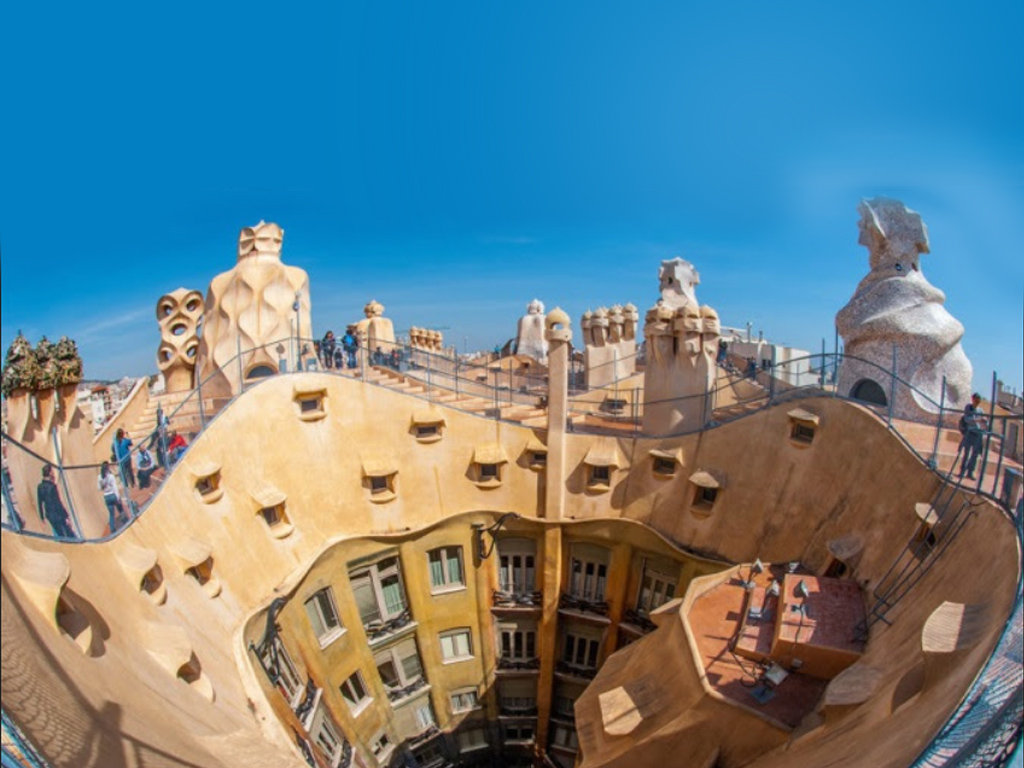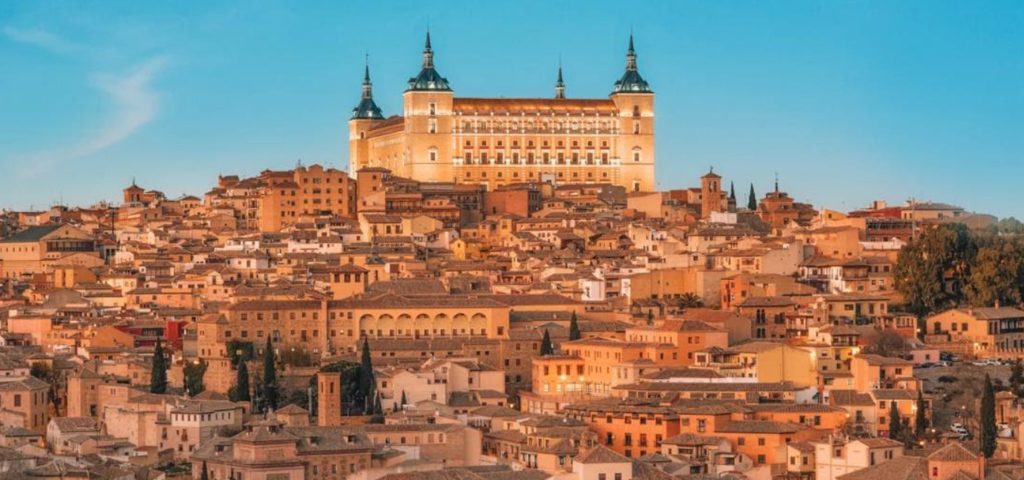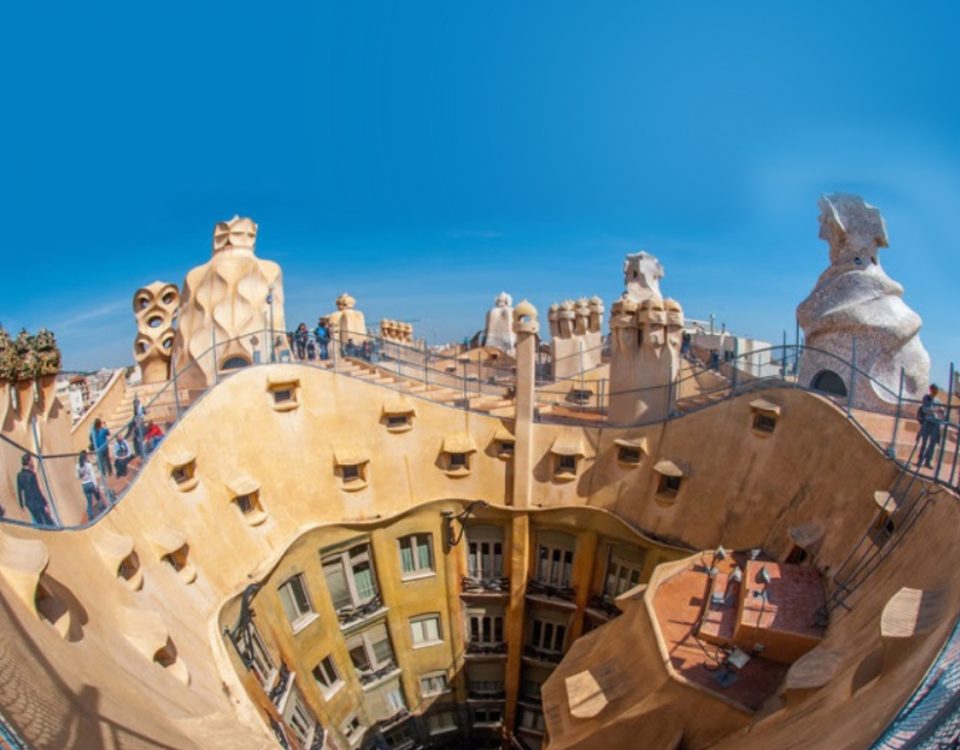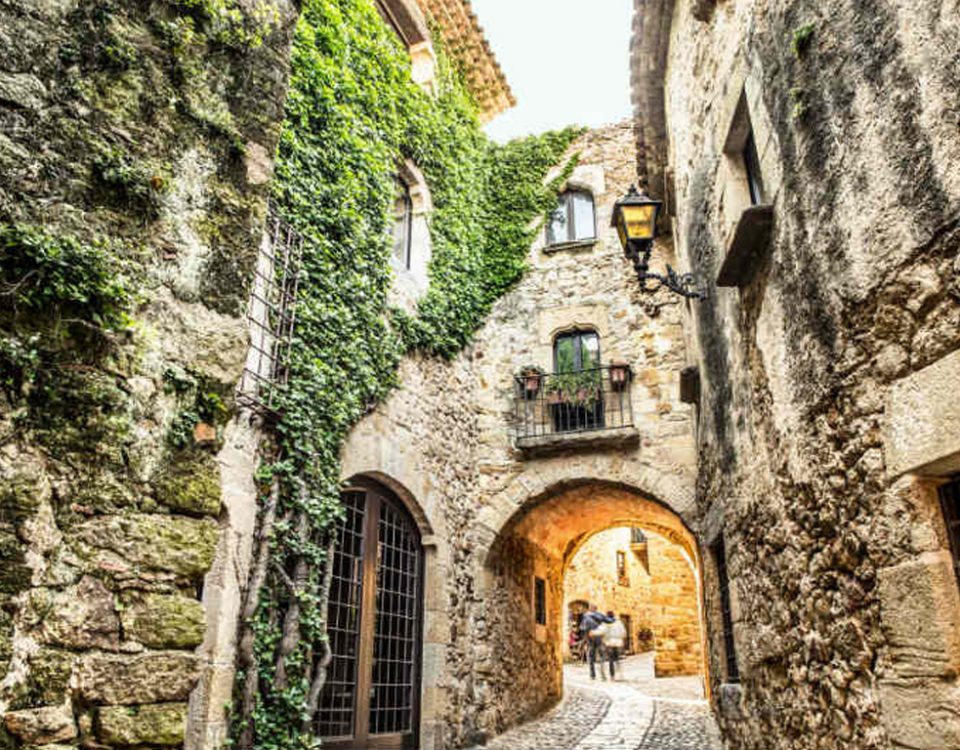Toledo

Barcelona
September 28, 2020Our exploration of Toledo, a city of dusty golds, caramels and honey hues perched high above the Tagus river situated in central Spain in the region of Castilla-La Mancha is crammed with site visits. No slow travel today. Romans were the first to occupy this city and build a fortress on the present day Alcazar. Capital city of the Visigoths in the 6th century AD they contributed many churches so Toledo became a center of literary importance. In the early 700s the Visigoth bishops and the king were defeated by Berbers and Moors. Under Moorish rule dominated from Berbers from North Africa and the Omeyyad Dynasty from Damascus, Visigoth bishops were not prosecuted. Toledo retained its’ importance as a literary and ecclesiastical centre. The conquest of Toledo by Alfonso VI in 1085 heralded the return of Christianity. Arab libraries were not pillaged and teachings were transcribed by Muslim and Christian scholars to share throughout Europe. Judaism, Christianity and Islam peacefully co-existed for centuries. No wonder it is known as “The City of the Three Cultures”. This magnificent model of a city of the middle ages surrounded on all sides by the river is a World Unesco Heritage Site and bewitching.
We enter through the medieval gate of the Puerta de Bisagara Nueva, a triumphal arch with a tower on each side built mid-16th century. A few metres away, basalt black is the ancient Puerta Antigua de Bisagara gateway. When Alfonso VI conquered Toledo in 1085, he entered it through this gateway along with El Cid. It is made of iron.
In the center of the city the steep narrow cobblestone streets and alleys are a maze of history. Whispers of stories seep out from underneath gigantic doors and roll off weathered stone walls so old the colours and materials are undistinguishable. Inlaid cement and glazed tiles of crosses, Stars of David, Arabic patterns and Islamic tiles mark the churches, synagogues and mosques that reside side by side. Our senses swallowed up by the diversity of art and architecture and numerous alley markers, we get lost. Disoriented we panic - for only a moment. Too bad, so sad! It means we’ll have more neighbourhoods to explore.
Given directions by kind locals, we wander down to the Plaza De Zocodovar to be greeted by the magnificent Toledo’s Cathedral (Catedral de Toledo). It is the second biggest Gothic Cathedral of Spain. The Cathedral of Toledo is often said to be one of Spain’s most beautiful, and it’s an excellent example of the Spanish gothic style. Construction started in the 13th century, and today it’s filled with incredible artworks by Caravaggio, Tiziano, Rubens and El Greco. There is much to see in this massive cathedral; it’s like threading through a busy town. El Greco’s “Disrobing of Christ” commissioned for the cathedral, holds court over a marble altar. Another Baroque altarpiece of marble, jasper and bronze, “Transparante” by Narcosco Tomé is other-worldly, only illuminated by an ornate skylight. The choir chair carvings are wooden and depict the battle of Granada while upper carvings are of alabaster and tell the tale of the Old Testament. In the Treasury is the 16th century Monstrance, the carrier of the Holy Sacrament, paraded through the streets of Toledo every May/June for the Feast of the Body and Blood of Christ. The procession, flanked by forty-eight 17th century Flemish tapestries hanging down city walls is led by the Monstrance. Two-and-a-half meters tall it is crowned with a diamond cross, constructed with two-hundred-and-fifty miniature gold and enamel statues and embellished with rubies, emeralds and sapphires. It’s an incredible sight to behold. Suspended from the gothic naves, we see several hanging red hats. These are placed right above the tombs of bishops, ready for when they return to life.
We decide to miss The Torture Museum offering 40 minutes of gruesome instruments of torture from the Spanish Inquisition and head out for lunch. Pre-planned we board a bus to take us over the river to the mountain chain that surrounds the city. The hotel Parador de Toledo’s restaurant and terrace face the city and the panoramic view is breathtaking. If only we could return for a leisurely cocktail to watch the city turn colours under the brilliant sun at sunset.
We return to the city via a drive around the river and a stop at Alcatrez, the highest summit of the city for photos. Charles V’s fortified palace stands on the site of former Roman, Visigoth and Muslim fortresses. At the bottom of the hill we enter the city again. Ascending the city up hundreds of stairs with the locals for a different view is not for those without strong legs and heart. There is still much to visit. Next is Iglesia de Santo Tomé - The Church of St. Thomas, a beautiful, simple church built on the site of an 11th century mosque. The reconstruction retained the minaret of the mosque and repurposed it as a bell tower. Faded frescoes from the original building peep out of the aged stone walls you line up to enter the small white church to visit the highlight, El Greco’s magnificently vibrant painting “The Burial of the Count of Orgaz.” Look the image up online, it’s worth the effort.
Outside the church artisan shops and bakeries line the small tree-lined square. We permit ourselves a few minutes to browse. A sword shop showcases daggers and swords. Toledo was considered the greatest sword-making centre in the world between the 15th and 18th centuries. Made of Damascus steel, these swords could split a feather in midair, yet retain their edge through many battles. The swords were easily recognized by a characteristic watery or ''damask'' pattern on their blades used by numerous warriors of the past, including the Crusaders. The store still forges swords to order. Estimated time to finish the sword is twenty days. Not far from the sword shop is a bakery. The windows display detailed marzipan shaped dragons, horses, windmills and the cathedral in colours of red, pink, white, gold and blue. The horses and windmills are the only nod to Don Quixote’s famous “Man of La Mancha” we’ve seen. Marzipan was brought to Toledo by the Arabs and is considered a Toledo specialty. Inside the bakery are boxes of saffron labelled DO Castilla La Mancha. Bright in colour, this saffron is considered some of the best in Spain. Fans of marzipan and saffron, these purchases are much easier to transport than swords and daggers. Wistfully, we leave the shops carrying dragons and saffron wishing we had more time to browse and visit the old marketplace a few blocks away.
In the area of the old medina - once the neighbourhood of wealthy Muslims - is the Mosque of Cristo de la Luz. Built in 999, and one of ten mosques in the city, it is extraordinary because though converted to a Church by King Alfonso in 1085, its architecture of red brick and stone Moorish and Gothic arches and naves has been mainly untouched and preserved to this day. The search for two inscriptions, one from the founder Ahmad ibn Hadidi in Kufi script, and another, legend has it, from King Alfonso, are a delightful challenge. We only find one. Another visitor helpfully points the other one out to us.
The dusklit empty beauty of vast sienna plains dotted by windmills and medieval castles accompany our journey to Madrid. The contrast of this blank land and Toledo’s rich history is a sensory overload. No wonder everything seems possible! It is!
Want posts like this and more right to your inbox? Subscribe to Takes & Tales and receive Inquisitive Traveller stories, food, wine, music and reading suggestions. You’ll also learn about upcoming historical haven destinations. Subscribe today! You can unsubscribe anytime!

We enter through the medieval gate of the Puerta de Bisagara Nueva, a triumphal arch with a tower on each side built mid-16th century. A few metres away, basalt black is the ancient Puerta Antigua de Bisagara gateway. When Alfonso VI conquered Toledo in 1085, he entered it through this gateway along with El Cid. It is made of iron.
In the center of the city the steep narrow cobblestone streets and alleys are a maze of history. Whispers of stories seep out from underneath gigantic doors and roll off weathered stone walls so old the colours and materials are undistinguishable. Inlaid cement and glazed tiles of crosses, Stars of David, Arabic patterns and Islamic tiles mark the churches, synagogues and mosques that reside side by side. Our senses swallowed up by the diversity of art and architecture and numerous alley markers, we get lost. Disoriented we panic - for only a moment. Too bad, so sad! It means we’ll have more neighbourhoods to explore.
Given directions by kind locals, we wander down to the Plaza De Zocodovar to be greeted by the magnificent Toledo’s Cathedral (Catedral de Toledo). It is the second biggest Gothic Cathedral of Spain. The Cathedral of Toledo is often said to be one of Spain’s most beautiful, and it’s an excellent example of the Spanish gothic style. Construction started in the 13th century, and today it’s filled with incredible artworks by Caravaggio, Tiziano, Rubens and El Greco. There is much to see in this massive cathedral; it’s like threading through a busy town. El Greco’s “Disrobing of Christ” commissioned for the cathedral, holds court over a marble altar. Another Baroque altarpiece of marble, jasper and bronze, “Transparante” by Narcosco Tomé is other-worldly, only illuminated by an ornate skylight. The choir chair carvings are wooden and depict the battle of Granada while upper carvings are of alabaster and tell the tale of the Old Testament. In the Treasury is the 16th century Monstrance, the carrier of the Holy Sacrament, paraded through the streets of Toledo every May/June for the Feast of the Body and Blood of Christ. The procession, flanked by forty-eight 17th century Flemish tapestries hanging down city walls is led by the Monstrance. Two-and-a-half meters tall it is crowned with a diamond cross, constructed with two-hundred-and-fifty miniature gold and enamel statues and embellished with rubies, emeralds and sapphires. It’s an incredible sight to behold. Suspended from the gothic naves, we see several hanging red hats. These are placed right above the tombs of bishops, ready for when they return to life.
We decide to miss The Torture Museum offering 40 minutes of gruesome instruments of torture from the Spanish Inquisition and head out for lunch. Pre-planned we board a bus to take us over the river to the mountain chain that surrounds the city. The hotel Parador de Toledo’s restaurant and terrace face the city and the panoramic view is breathtaking. If only we could return for a leisurely cocktail to watch the city turn colours under the brilliant sun at sunset.
We return to the city via a drive around the river and a stop at Alcatrez, the highest summit of the city for photos. Charles V’s fortified palace stands on the site of former Roman, Visigoth and Muslim fortresses. At the bottom of the hill we enter the city again. Ascending the city up hundreds of stairs with the locals for a different view is not for those without strong legs and heart. There is still much to visit. Next is Iglesia de Santo Tomé - The Church of St. Thomas, a beautiful, simple church built on the site of an 11th century mosque. The reconstruction retained the minaret of the mosque and repurposed it as a bell tower. Faded frescoes from the original building peep out of the aged stone walls you line up to enter the small white church to visit the highlight, El Greco’s magnificently vibrant painting “The Burial of the Count of Orgaz.” Look the image up online, it’s worth the effort.
Outside the church artisan shops and bakeries line the small tree-lined square. We permit ourselves a few minutes to browse. A sword shop showcases daggers and swords. Toledo was considered the greatest sword-making centre in the world between the 15th and 18th centuries. Made of Damascus steel, these swords could split a feather in midair, yet retain their edge through many battles. The swords were easily recognized by a characteristic watery or ''damask'' pattern on their blades used by numerous warriors of the past, including the Crusaders. The store still forges swords to order. Estimated time to finish the sword is twenty days. Not far from the sword shop is a bakery. The windows display detailed marzipan shaped dragons, horses, windmills and the cathedral in colours of red, pink, white, gold and blue. The horses and windmills are the only nod to Don Quixote’s famous “Man of La Mancha” we’ve seen. Marzipan was brought to Toledo by the Arabs and is considered a Toledo specialty. Inside the bakery are boxes of saffron labelled DO Castilla La Mancha. Bright in colour, this saffron is considered some of the best in Spain. Fans of marzipan and saffron, these purchases are much easier to transport than swords and daggers. Wistfully, we leave the shops carrying dragons and saffron wishing we had more time to browse and visit the old marketplace a few blocks away.
In the area of the old medina - once the neighbourhood of wealthy Muslims - is the Mosque of Cristo de la Luz. Built in 999, and one of ten mosques in the city, it is extraordinary because though converted to a Church by King Alfonso in 1085, its architecture of red brick and stone Moorish and Gothic arches and naves has been mainly untouched and preserved to this day. The search for two inscriptions, one from the founder Ahmad ibn Hadidi in Kufi script, and another, legend has it, from King Alfonso, are a delightful challenge. We only find one. Another visitor helpfully points the other one out to us.
The dusklit empty beauty of vast sienna plains dotted by windmills and medieval castles accompany our journey to Madrid. The contrast of this blank land and Toledo’s rich history is a sensory overload. No wonder everything seems possible! It is!
Want posts like this and more right to your inbox? Subscribe to Takes & Tales and receive Inquisitive Traveller stories, food, wine, music and reading suggestions. You’ll also learn about upcoming historical haven destinations. Subscribe today! You can unsubscribe anytime!





